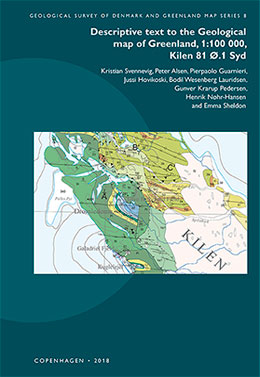Descriptive text to the Geological map of Greenland, 1:100 000, Kilen 81 Ø.1 Syd
DOI:
https://doi.org/10.34194/geusm.v8.4526Keywords:
Geological mapping, Kilen, North Greenland, Wandel Sea Basin, Upper Palaeozoic, Mesozoic, inversion tectonics, rifting, compressionAbstract
The geological map sheet of Kilen in 1:100 000 scale covers the south-eastern part of the Carboniferous–Palaeogene Wandel Sea Basin in eastern North Greenland. The map area is dominated by the Flade Isblink ice cap, which separates several minor isolated landmasses. On the semi-nunatak of Kilen, the map is mainly based on oblique photogrammetry and stratigraphical field work while in Erik S. Henius Land, Nordostrundingen and northern Amdrup Land the map is based on field data collected during previous, 1:500 000 scale regional mapping. Twenty-one Palaeozoic–Mesozoic mappable units were identified on Kilen, while the surrounding areas comprise the Late Cretaceous Nakkehoved Formation to the north-east and the Late Carboniferous Foldedal Formation to the south-west. On Kilen, the description of Jurassic–Cretaceous units follows a recently published lithostratigraphy. The Upper Palaeozoic–lowermost Cretaceous strata comprise seven formations and an informal mélange unit. The overlying Lower–Upper Cretaceous succession comprises the Galadriel Fjeld and Sølverbæk Formations, which are subdivided into six and five units, respectively. In addition, the Quaternary Ymer Formation was mapped on south-east Kilen. The Upper Palaeozoic to Mesozoic strata of Kilen are faulted and folded. Several post-Coniacian NNW–SSE-trending normal faults are identified and found to be passively folded by a later N–S compressional event. A prominent subhorizontal fault, the Central Detachment, separates two thrust sheets, the Kilen Thrust Sheet in the footwall and the Hondal Elv Thrust Sheet in the hanging wall. The style of deformation and the structures found on Kilen are caused by compressional tectonics resulting in post-extensional, presumably Early Eocene, folding and thrusting and basin inversion. The structural history of the surrounding areas and their relation to Kilen await further studies.
Published
Issue
Section
License
Copyright (c) 2018 Kristian Svennevig, Peter Alsen, Pierpaolo Guarnieri, Jussi Hovikoski, Bodil Wesenberg Lauridsen, Gunver Krarup Pedersen, Henrik Nøhr-Hansen, Emma Sheldon

This work is licensed under a Creative Commons Attribution 4.0 International License.
This article is distributed under a CC-BY 4.0 licence, permitting free redistribution and reproduction for any purpose, even commercial, provided proper citation of the original work. Author(s) retain copyright over the article contents.


